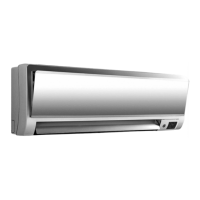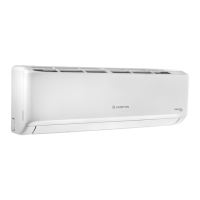Do you have a question about the Ariston NIMBUS COMPACT S NET and is the answer not in the manual?
| Refrigerant | R32 |
|---|---|
| Connectivity | Wi-Fi |
| Remote Control | Yes |
| Timer Function | Yes |
| Auto Restart | Yes |
| Power Supply | 230V/50Hz |
Covers safe use of tools, handling dust, and electrical safety.
Ensures safe working conditions, secure ladders, and fall prevention.
Protects the appliance and workplace, emphasizes careful handling.
Covers personal protective equipment, handling sharp parts, and emergency procedures.
Emphasizes qualified staff, avoiding flammable materials, and proper system placement.
Details CE compliance and guidelines for proper product disposal at end-of-life.
Lists the components of the Nimbus Compact S system and available external units.
Provides physical dimensions and weights for external units.
Details the internal unit's dimensions, overall view, and component labels.
Covers technical specifications, conformity, and installation of the system interface.
Explains positioning, wiring, and provides product fiche information for the outdoor sensor.
Covers refrigerant compatibility, material usage, and optimal placement for the outdoor unit.
Details minimum clearance requirements for installing the outdoor unit.
Describes securing the base, opening passages, and removing the front panel for installation.
Specifies minimum clearances required for the internal unit's proper maintenance and function.
Guides on removing the front panel, draining the safety valve, and filling the system.
Outlines steps for preparing and starting the heating/cooling system after installation.
Covers safety precautions, pipe shaping, and handling refrigerant R-410A.
Details procedures for evacuating air, checking for leaks, and purging the system.
Provides a step-by-step guide for charging the refrigerant gas into the system.
Explains the pump-down process for refrigerant recovery and provides relevant data.
Lists checks required before connecting the water circuit to the indoor module.
Illustrates the complete system layout and provides a legend for its components.
Advises on installing oil traps based on height differences between indoor and outdoor units.
Covers essential safety warnings, grounding, and connection procedures before electrical work.
Specifies power supply requirements, voltage limits, and RCCB recommendations for internal units.
Lists electrical specifications, cable types, and circuit breaker sizes for internal units.
Explains how to connect power and communication cables to the external unit's terminal block.
Discusses thermostat control logic and provides terminal block diagrams for 1-phase and 3-phase connections.
Guides on accessing the internal unit's electrical panel and lists all connection points.
Details terminal block connections and cable sizing requirements for the internal unit.
Focuses on connecting the internal and external units via MODBUS communication, including safety notes.
Presents electrical wiring diagrams for 1-phase and 3-phase external units.
Shows the detailed electrical wiring diagram for the internal unit models FS 90 and 100 S.
Shows the detailed electrical wiring diagram for the internal unit model FS 70 S.
Shows the detailed electrical wiring diagram for the internal unit models FS 40 and 50 S.
Provides guidance on optimal placement and steps for wall-mounting the system interface.
Explains how to connect the interface to the internal unit using the BUS protocol.
Explains the meaning of various display symbols and the functions of the interface buttons.
Details the status indicated by the different colored LEDs on the unit.
Guides through the initial startup process, including language and date/time settings.
Explains how to access the technical area for advanced settings and network configuration.
Covers summer/winter changeover, temperature thresholds, and zone settings for thermoregulation.
Details how to adjust the heating curve slope and temperature offset for optimal performance.
Explains how to set cooling temperatures and select thermoregulation types for Zone 1.
Covers adjusting the cooling curve slope and offset for different system types.
Outlines essential annual checks, safety measures, and refrigerant pressure checks.
Provides guidance for users and explains the unit's antifreeze protection mechanism.
Emphasizes correct hydraulic connections and water quality requirements for system longevity.
Lists internal unit error codes, their descriptions, and corresponding troubleshooting steps.
Explains BUS power supply overload issues and provides a table for external unit inverter error codes.
Details specific inverter error codes for 1-phase and 3-phase external units.
Explains the information found on the internal and external unit data plates.
Provides details on refrigerant type, load, GWP, and CO2 equivalent for different models.











